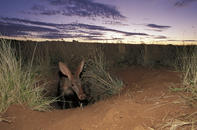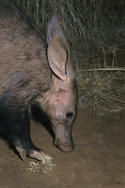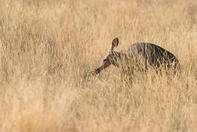Perfectly Designed

The aardvark is unmistakable by its strange shape. It is an ant and termite specialist and is superbly adapted for this. Aardvarks have only a few reduced peg-like teeth as they don’t need to chew. Instead, their stomachs are adapted to grinding much like the gizzard of a bird.
Aardvarks have very unique droppings, which are small oval pellets that comprise of termite heads and the excess soil they can’t help but swallow while foraging. These are seldom found as the aardvark defecates in a shallow scrape and then covers its dung.
Body Parts

A muscular, movable muzzle is suited to poking into small excavations to sniff for prey or lick up termites. This has closing slit-like nostrils well endowed with hair to prevent sand from entering during digging forays.
The aardvark’s tongue is long and covered with copious amounts of saliva to which ants and termites stick and are thus taken up into the mouth. Facial bristles protect the aardvarks eyes while it burrows and may even help it to detect the tiny vibrations of its prey.
The large ears which can rotate are an adaptation to hearing prey and detecting predators but can be conveniently folded away to keep them free of sand. Powerful digging claws are present on the front feet to enable the aardvark to excavate for its food. The short tail tapers to a point and leaves drag marks in the sand where the aardvark has walked.
Solo

Aardvarks are solitary animals coming together only to mate. While their sense of smell is well developed they do not see particularly well and are especially cautious when they leave their burrows in the evenings pausing and sniffing to ensure there are no imminent threats.
Although aardvarks are usually back in their burrows before dawn, they may occasionally come out of their underground domain’s to catch some sun after a, particularly cold night.
By Megan Emmett